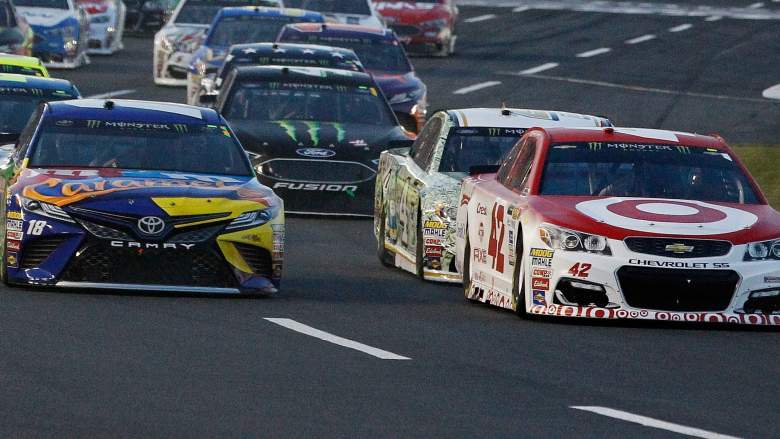
Getty NASCAR made a few tweaks to the rules for the 2018 All-Star Race.
For the first time ever, fans will get restrictor plate racing at Charlotte Motor Speedway. NASCAR tweaked the rules for the 2018 All-Star Race in an attempt to create more exciting racing from start to finish for the $1 million purse. According to NASCAR, the rules package was inspired by the 2017 Indianapolis race that created a record number of lead changes. NASCAR overtime rules are also in place, meaning the race must end with green flag racing.
The All-Star Race will be a total of 80 laps with four stages. The new format makes the race 10 laps longer than the 2017 race. Here’s how NASCAR describes the 2018 All-Star format.
The race is scheduled for four stages. Stage 1 is scheduled to end at Lap 30, Stage 2 at Lap 50, Stage 3 at Lap 70, and a final shootout that ends at the Lap 80 distance. Only green-flag laps will count in the final stage. In a new wrinkle to previous formats, NASCAR Overtime rules will be in effect for the end of each stage.
The new rule changes for the cars has been met with a mix of intrigue and skepticism. The hope is the restrictions will make the race more competitive. NASCAR breaks down the new requirements for race teams as well as why the changes were made.
The rules package the cars will run. Restrictor plates will be in use at 1.5-mile Charlotte Motor Speedway, along with a 6-inch high spoiler (with two 12-inch ears), a 2014 style splitter and aero ducts…It’s designed to promote passing and tight competition. It’s very similar to the package the NASCAR Xfinity Series used at Indianapolis last year, a race which set a record number of leaders and lead changes…The entire package is designed to give the trailing car more of an aerodynamic advantage. You’ll see more slingshot-style moves and passes for the lead.
How did the drivers qualify for the 2018 NASCAR All-Star Race? The field is made up of race winners from 2017 and 2018. Additionally, past series champions as well as All-Star Race winners were also eligible as long as they are full-time drivers. Three spots were open for the stage winners from the NASCAR All-Star Open that ran prior to this race. Finally, the fans voted in one driver.
Kyle Busch won last year’s race, and is looking to add another $1 million to his earnings. The driver spoke with NASCAR about why this race is so exciting.
“For us, being an all-star and being in the All-Star Race is one of the most fun things we get to do each year,” Busch told NASCAR (via CBS Sports). “I’d say the Clash is another one of those and, with the All-Star Race, they are certainly two fun races where we get a chance to go after just a win and bring home the checkers or end up on the wrecker…It’s an exciting night and there’s a lot of energy there. It gives you the opportunity to run that many qualifying laps in a row. That’s all you’re doing – you’re giving it all you’ve got every single lap.”
While the purse for the 2018 All-Star Race is $1 million, it does not necessarily mean all the money goes to the driver. ESPN explains how each team has a different way to divide the spoils.
The winner earns $1 million. Or at least that is what the team gets. It is up to the team owner to distribute the money to the team members, depending on how their contracts read.